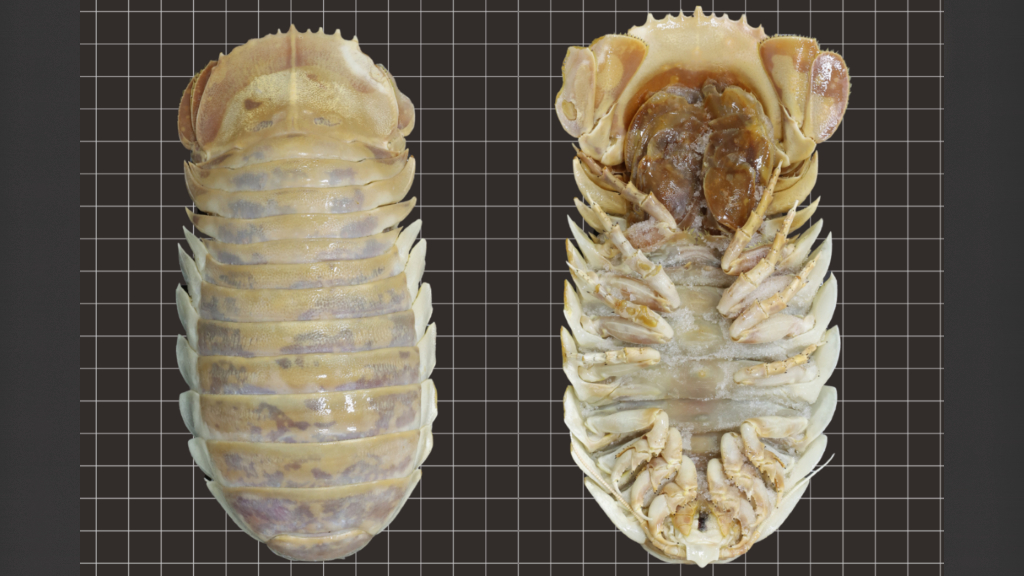Creepy deep-sea 'vanilla Vader' woodlouse is 25 times bigger than a land louse
The new Bathynomus species scavenges in the deep ocean.
A colossal, creamy yellow woodlouse relative that has a vague resemblance to Darth Vader has been discovered deep below the ocean surface in the Gulf of Mexico, a new study finds.
At more than 10 inches (26 centimeters) long, the creature is 2,500% larger than common roly polies, or woodlice (Oniscus asellus) that are found chewing on decaying matter in most people's backyards. This blond behemoth is the latest addition to a group of about 20 deep-sea crustaceans in the genus Bathynomus that live in the benthic zone, the deepest reaches of the ocean, according to a statement.
Bathynomus species are sometimes called the "Darth Vader of the Seas," perhaps because their heads share similarities with the "Star Wars" character's helmet, Live Science previously reported. If that's the case then "vanilla Vader" might be an appropriate name for this pale new addition to the genus.
Researchers identified the species from a single specimen caught off the Yucatán Peninsula in Mexico in 2017, and they named it Bathynomus yucatanensis after the region. Bathynomus members look similar, and researchers originally assumed the individual was a known species called B. giganteus, one of two previously identified species that inhabit the Gulf, until a genetic analysis suggested it was an unknown species sharing the same waters.
"The ecological diversity of the Gulf of Mexico may be more complex than [previously] thought," study lead author Huang Ming-Chih, an associate professor at the National University of Tainan in Taiwan, told Live Science in an email.
Related: Massive 'Darth Vader' sea bug pulled from waters near Indonesia
Bathynomus species are isopods, an order of crustaceans that includes woodlice. Scavenging in the deep ocean, Bathynomus species are rarely seen by people. The specimen from the Gulf of Mexico used to identify B. yucatanensis came from a baited cage trap set at about 2,000 feet to 2,600 feet (600 to 800 meters) below sea level.
Get the world’s most fascinating discoveries delivered straight to your inbox.
The Enoshima Aquarium in Japan kept the specimen under the assumption it was B. giganteus until Huang obtained it as part of research investigating Bathynomus. Huang analyzed the specimen's DNA and found that it differed from B. giganteus in the sequence of two genes — cytochrome c oxidase subunit 1 (COI) and 16S rRNA. A second specimen from the aquarium that underwent the same analysis produced a match for B. giganteus, further suggesting the first specimen was something different.
"I was skeptical," Huang said. "Since Enoshima Aquarium in Japan only purchased B. giganteus, I always thought it was B. giganteus." Huang studied the morphology of the specimen with two other experts. They found that the specimen with different genes was shorter and more slender than B. giganteus, with longer antennae and a body shape that more closely resembled an inverted triangle. What's more, the newly identified species' creamy yellow coloration differentiated it from its grayer cousins. From these morphological differences and the genetic analysis, the team concluded that it was a newfound species.
Both species have the same number of spines at the ends of their bodies, called pleotelson spines, that the researchers infer are an expression of age and maturity. The researchers noted this similarity makes it easy to misidentify B. yucatanensis.
Given that B. yucatanensis is so similar to B. giganteus, it's likely that the two share a common ancestor, the researchers wrote in the study.
The study was published online Wednesday (Aug. 10) in the Journal of Natural History.
Originally published on Live Science.

Patrick Pester is the trending news writer at Live Science. His work has appeared on other science websites, such as BBC Science Focus and Scientific American. Patrick retrained as a journalist after spending his early career working in zoos and wildlife conservation. He was awarded the Master's Excellence Scholarship to study at Cardiff University where he completed a master's degree in international journalism. He also has a second master's degree in biodiversity, evolution and conservation in action from Middlesex University London. When he isn't writing news, Patrick investigates the sale of human remains.



